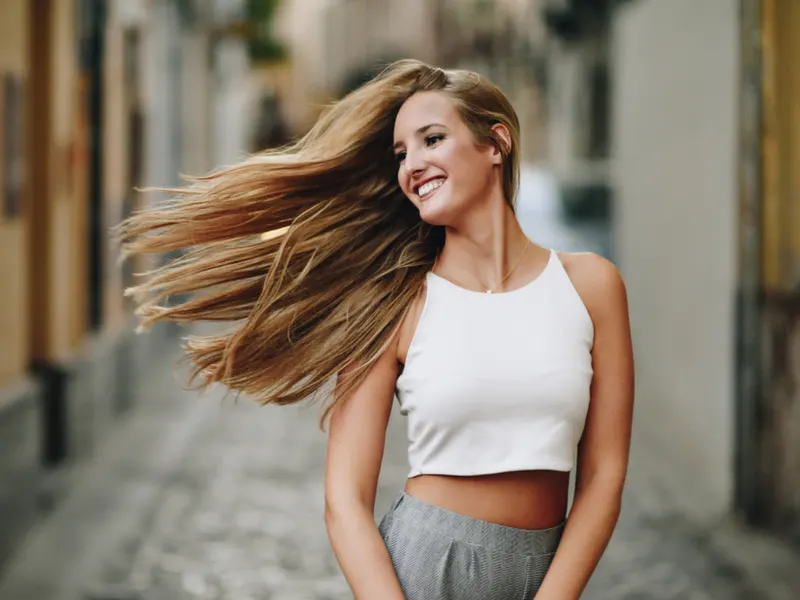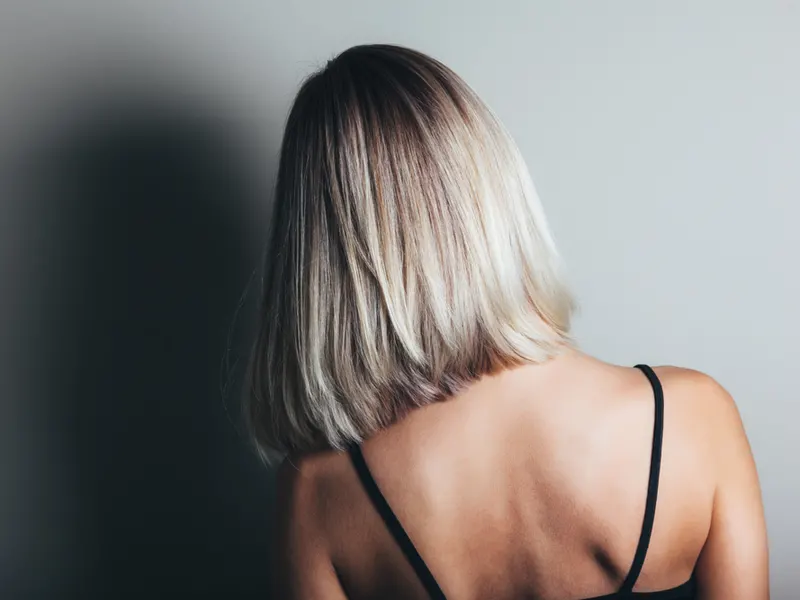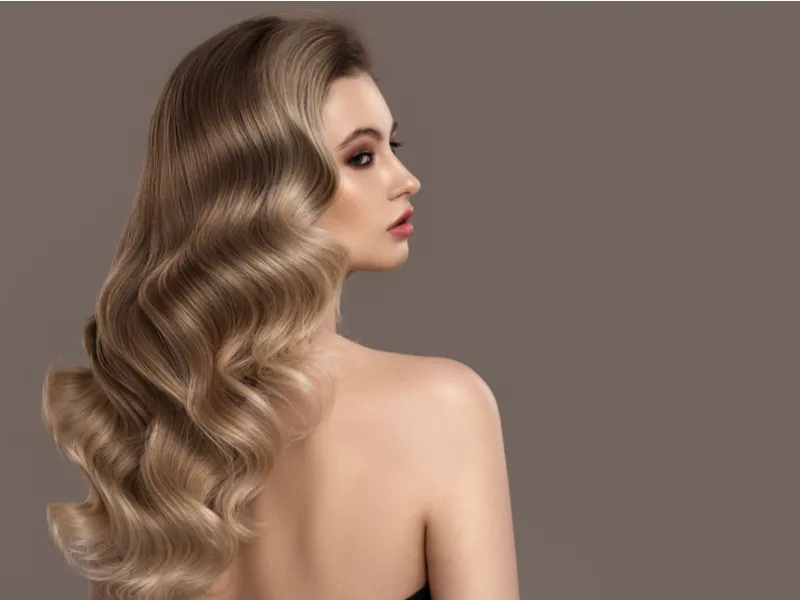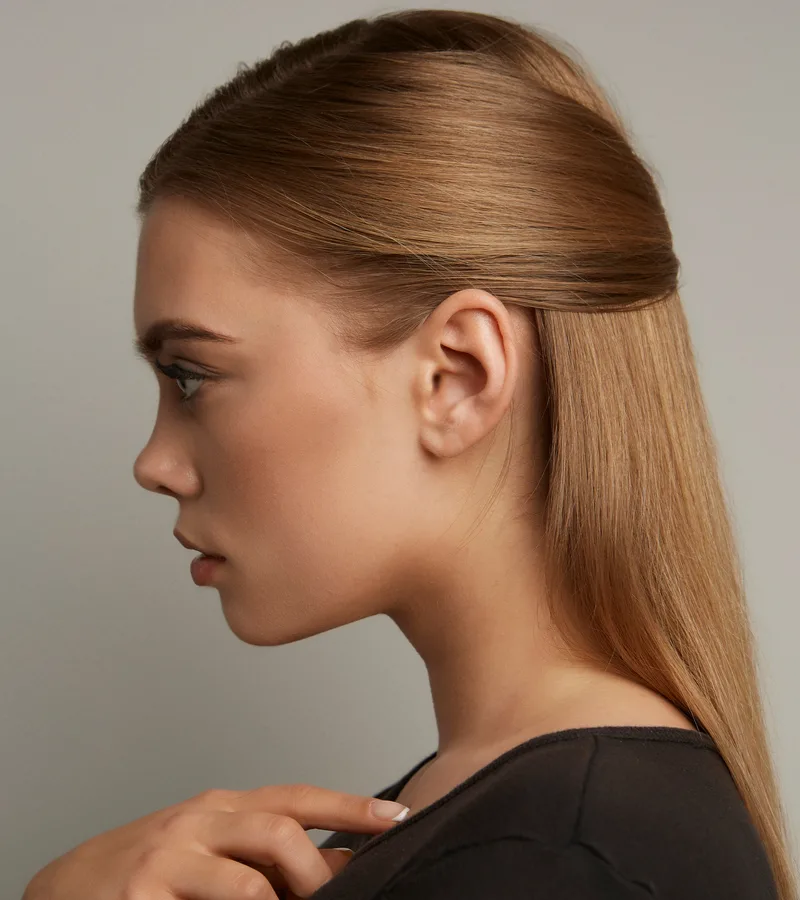Jump to:
Straight with a little extra body and bend in strands, the 1B hair type typically features medium-thick texture. Learn how to combat excess scalp oil and encourage a little more movement from this hair type with our quick reference care guide for 1B hair!
What Is the 1B Hair Type?

Javi_indy/Shutterstock
Type 1B hair is straight, but features some degree of bend in strands from the midshaft to the ends. Individual strands are medium-thick in texture (usually not fine or coarse), leading to a full and thick, healthy appearance with plenty of shine.
The 1B hair type deals with some unique challenges common to all the type 1s (1A, 1B, and 1C).
It’s prone to oiliness due to the straight shape of each strand. Without wave or bend at the roots, it’s easy for natural scalp oil (sebum) to travel along each strand and give hair that trademark greasy look and feel within a day or two after washing.
It’s unsuited for commonly used heavy hair products like creams, gels, and oils. Even typically lightweight products like mousse can overwhelm straight 1B hair.
The general characteristics of the 1B hair type are:
- Straight strands with small amounts of bend and body from midshaft to ends
- Medium strand texture (not fine or coarse)
- Appears thick, voluminous, and shiny when healthy
- May struggle to hold a curl without products
- Heavy products (creams, oils, gels) easily overwhelm and weigh down the hair
Not sure if 1B accurately describes your hair type? You could fall under one of the similar hair types below. Compare the features of each hair type to see which one best describes your own hair.
- Type 1A: Pin-straight, shiny hair with fine texture; prone to oiliness at the roots and struggles to hold a curl with or without products.
- Type 1B: Mostly straight, shiny hair with medium texture and some bending from midshaft to ends; prone to oiliness at the roots and may struggle to hold a curl without products.
- Type 1C: Mostly straight, coarse-textured hair with extra body and some bending from midshaft to ends; prone to frizz, oiliness at the roots, and easily holds a curl.
If you have the medium strand texture and some trace of bending beginning at the midshaft or near the ends, you probably have type 1B hair. Take our quiz to double check and learn your actual hair type: Take Our Hair Type Quiz!
Keep reading to learn more about this unique, mostly-straight hair type.
Best Features of 1B Hair
Having 1B hair can be a great thing! This low-maintenance hair type is naturally shiny and smooth with very little frizz. It boasts some natural volume and appears full, thick, and healthy. Let’s take a look at some of the best features of 1B hair.
Low-Maintenance
While other hair types need a lot of products or styling to look their best, the 1B hair type is low-maintenance by comparison. It doesn’t require much from you and the natural texture is very slight. So you won’t always need to heat style or blow dry with a round brush to perfect it.
The mostly straight texture is perfectly suited to air drying, making hair care a little easier. And since many products are too heavy for this medium-textured hair type, you won’t need to douse your strands in multiple products to make it manageable or to style it.
Naturally Shiny and Smooth
The 1B hair type is naturally smooth and shiny, thanks to the straight strand shape and medium strand texture. Coarser hair types have to deal with frizz and “fluffy” volume, but 1B hair gets a natural sleekness and shine.
You can thank your abundant scalp oil (sebum) for that.
Since your strands are mostly straight, it’s easy for oil to moisturize and nourish your strands from the roots to the ends. With plenty of natural moisture, you have naturally built-in frizz protection that leaves your mane looking smooth, shiny, and healthy.
Natural Volume and Thickness
The 1B hair type is also known for its natural volume and thickness. Every strand is medium-thick (about the same thickness as a thread), lending your mane a full, dense, thick appearance – even if you don’t actually have a ton of hair.
With plump, moisturized strands packed closely together, 1B hair achieves flattering natural volume when it’s freshly cleansed. It does lose volume over time after washing as scalp oils begin to weigh down the hair at the roots. But using dry shampoo and root lifting products can combat this problem easily!
Strong and Resistant to Breakage
Type 1B hair is naturally strong and resistant to breakage. Curls and bends along a hair strand create weak points where it’s easy for hair to break and snap off with the slightest manipulation or friction.
With 1B hair, that issue doesn’t exist. You get the benefit of naturally strong, protein-fortified strands that better stand up to breakage. This is especially beneficial when you’re actively growing out your hair.
Breakage sacrifices new length, making it appear that hair isn’t growing like it should. With the 1B hair type, you likely notice that accumulating length is easy and doesn’t seem to take long.
Worst Features of 1B Hair
You’re here for the truth about this hair type – the good and the bad. While 1B hair is generally low-maintenance and easy to care for, it does come with its fair share of challenges. Here are some of the worst features of 1B hair.
Prone to Oiliness
The same natural scalp oils that make your hair well-moisturized, shiny, and smooth also make your 1B mane prone to oiliness at the roots. People with 1B hair tend to accumulate noticeable oil at the roots within a day or two after washing.
This can make it difficult to adopt the “wash less often” hair care rule. Since you need to wash 1B hair more often than more textured hair types, it’s easy to strip away your natural moisture and leave your strands dry. This can turn into a vicious cycle.
You might try using heavy moisturizing products to correct the problem, which further weigh your strands down and make them look greasy, triggering another shampoo session and continuing the cycle. We’ll show you how to manage this excess oiliness in the Maintenance and Care Tips section below.
Read Next: Why Is My Hair So Oily?
Needs Product to Hold a Curl
Type 1B hair has medium strand thickness, so it’s better at holding a curl than pin-straight 1A hair. But you’ll find that your curls quickly fall out unless you use some type of lightweight support product (like mousse).
Hair types with a little more texture can hold a curl or wave without products, but if you want to rock a wavy or curly look for a day, you’ll need to support the texture with a foamy mousse product with a little hold.
Inconsistent Strand Shape
Many people with 1B hair find that their “in-between” strand shape or texture can be frustrating to deal with. It’s mostly straight, but it’s not pin-straight and sleek.
When you air dry this hair type, you’ll end up with some shape/bend inconsistencies throughout. It’s not quite enough to fully wave, but it’s a little too much bend to pass off as perfectly straight.
If you’re a fan of the loosely tousled, casual look, that works out perfectly. But if you’re after a sleeker look, you’ll have to heat style with a flat iron to achieve a truly straight look.
Maintenance and Care Tips for 1B Hair
Taking good care of 1B hair is pretty simple and straight-forward. As long as you adopt the right shampoo schedule and follow best practices for drying and styling this hair type, you’ll find 1B hair care easy and quick without a ton of products needed or steps to take.
Washing 1B Hair
- Wash every 2-3 days with lightweight shampoo
- Use dry shampoo in between wash days
- Condition midshaft to ends only
- Deep condition once a month
You should wash 1B hair every 2-3 days ideally. Washing with a special, lightweight shampoo formulated for oily hair will make a big difference in how long you can go between washes. We list the best shampoos for your hair type here: Best Shampoo for Oily Hair.
If your hair gets noticeably oily before day 3, we recommend using dry shampoo to buy yourself a little more time between washes. We tested the most popular dry shampoos to find the best options for oily hair. See our top picks here: The 7 Best Dry Shampoos for Oily Hair.
When you wash your hair, you should follow up with conditioner. Don’t skip it! To avoid making your oil issues worse, avoid applying conditioner directly to your roots. Instead, experiment with conditioner application to find what works best for you.
Applying from midshaft to ends or ends only will likely be your best option. This ensures you don’t end up with the oily roots/dry ends conundrum so common to type 1B.
Another “hack” for dealing with oily 1B hair is deep conditioning once a month. This sounds counterintuitive because typically extra, heavy moisture only makes the oiliness worse. But your scalp may be over-producing oil due to underlying dryness from washing so often.
Deep-conditioning once a month can correct the underlying dryness and restore your scalp’s moisture balance. Grab some tips for deep conditioning the right way here: How to Deep Condition Hair.
Drying 1B Hair
- Air dry most of the time with limited blow drying
- Experiment with air dry styles (heatless waves and curls)
- Apply heat protectant before blow drying or heat styling
- Use anti-frizz serum if frizz is an issue
Drying 1B hair can be done without heat (air drying) or with heat (blow drying). There are pros and cons for each method.
Air drying without heat is the healthiest option and won’t cause any heat damage to your medium-textured, mostly-straight strands. But it does limit how you can style your hair.
You can try heatless waves and curls by twisting your hair into specific styles while it’s damp (we’ll cover this in more detail in the next section).
Drying 1B hair with heat using a hair dryer has the potential to cause heat damage, but there are ways to safely do it. Using a spray-on heat protectant is a quick way to protect strands from the high, direct heat of a blow dryer.
Using your hair dryer on the lowest heat setting will further protect your strands from heat damage. Try to make blow drying the exception, not the rule.
Type 1B hair typically doesn’t struggle a lot with frizz, but it can be an issue, especially if your hair is on the drier side. Anti-frizz serum (we like Garnier Fructis Sleek and Shine Anti-Frizz Serum, $3.99) can help you air dry or blow dry your hair to a smooth, shiny finish.
Apply a tiny amount and smooth with your palms to avoid overwhelming your hair or making it look greasy. And yes — it’s really that easy to use!
Styling 1B Hair
Styling 1B hair presents you with endless options. You can let your naturally straight texture shine, air dry or heat style waves or curls, or experiment with a range of cute half-up and updos. With your medium strand texture and easily-moldable strand shape, there’s not much you can’t do with 1B hair.
You can air dry to your natural, mostly straight texture. Or you can wind your damp, clean hair into braids, buns, or twists to create heatless, air-dried waves or curls that last all day.
Many people with 1B hair find that air dried curls and waves last longer than they do when heat styled with a curling wand or iron. Heat styling 1B hair is relatively easy since you have full, but not overly thick, hair.
As long as you use heat protectant first, you can use a curling wand or iron to style anything from loose waves to tight curls in 1B hair. Getting them to stick around longer than a few hours can be tough for this hair type, though.
We recommend working a lightweight mousse into the midshaft to ends before heat styling to make the style last longer. Here are some of our favorite styles for 1B hair.
Air Dry to Show Off Your Texture

Alena Ozerova/Shutterstock
Air drying helps you avoid heat damage while showing off the very subtle bends near the ends of your naturally straight, medium-textured hair. To nail your air dried, down and loose style, brush through your damp hair gently.
Smooth on a small amount of anti-frizz serum if your hair tends to frizz up when it dries. Try piecing out the ends with a small amount of wax to really highlight your texture!
Overnight Bun Curls

YuriyZhuravov/Shutterstock
Just because your hair is straight doesn’t mean you always have to wear it that way! Winding your hair into two large coiled buns while it’s wet will give you gorgeous, voluminous curls the next morning.
Combined with your natural smoothness and shine, this style will become one of your favorites because it’s so easy.
Apply a little mousse and divide your hair into 2 large sections. Coil each section into a twist, then wrap the twist around itself to form a coiled bun. Secure with a scrunchy or clip, then take down in the morning to reveal your curls!
Try a Chic Half-Up Style

Red Umbrella and Donkey/Shutterstock
When your roots begin to show signs of getting greasy, a quick spritz of dry shampoo and a half-up style can solve the problem!
Create a side or middle part and spray dry shampoo at your roots, then work it in. Use a small clip, bobby pins, or a barrette to secure the front pieces at the crown of your head for a quick, chic style.
The 1B Hair Type: Final Thoughts
We’ve covered most of the basics concerning type 1B hair. What else should you know so you can take the best care of your straight hair? Here are a few final things to consider.
- Get a better hair dryer. If you ever blow dry your 1B hair, you need a good dryer to ensure you’re not causing unnecessary heat damage and frizz. We have a list of our favorite hair dryers here, along with tips on which dryer is best for your hair type!
- Go as long as you can between washes. While the general recommendation is waiting 2-3 days between shampoos, if you can go longer, you should. The more contact your hair has with your natural sebum, the healthier and more hydrated it’ll be. If you’ll be out of public view for a few days and can handle the oiliness, see if you can wait 4 or 5 days before washing again. You’ll help train your hair to produce less oil over time.
- Don’t skip the conditioner. Since you’re prone to oiliness, conditioner can seem like an optional product. It’s not! Your hair still needs moisture, so don’t skip conditioner after shampooing. And do try deep conditioning once a month – you might find that it balances your scalp’s oil production and leaves you with shinier, smoother, stronger hair.
- Keep things light. Your hair has a medium texture and can’t handle very heavy products like most gels, creams, and oils. Unless you’re doing a treatment that will be washed out, skip heavy products to avoid weighing your strands down.
If you’ve read through the guide and still aren’t quite sure you’ve properly typed your hair, we’ve got you covered. Take our quick hair type quiz next to find what your actual hair type is and get some tips to help it look and feel its best: Take Our Short Hair Type Quiz!
